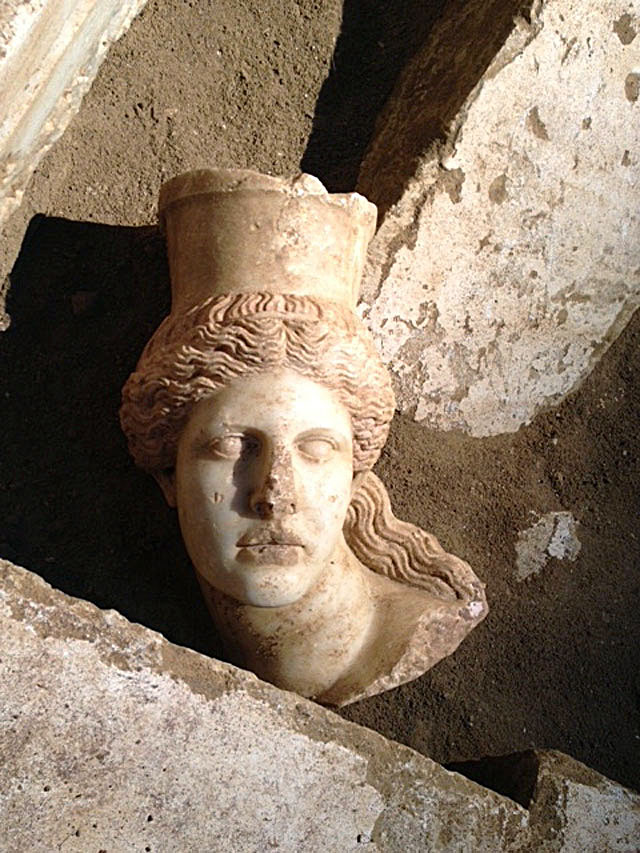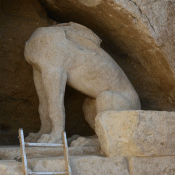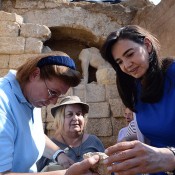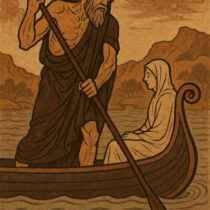People were “led” by archaeologist Katerina Peristeri into the “sanctum sanctorum” of the funerary monument on the Kasta hill of Amphipolis, after attending the 2nd Symposium on Sustainable Tourist Development for the region of Amphipolis in the West Pangaion Hills, organized last week end in Serres by the “Odi Amphipoleos” Society.
With the participation of all the excavation team made up of architect Michalis Lefantzis, geophysicist Gregoris Tsiokas, geologists Spyros Pavlidis and Giorgos Seiridis, Katerina Peristeri presented through numerous photographs all those elements that make this funerary monument so unique.
The eminent archaeologist referred to the sealing of the monument by the last Macedonians in the 2nd century BC and the excavation’s moveable finds: vases, a few coins and of course the remains of the death bed, far back in the fourth room. She also pointed out that there were not many moveable finds, since initial estimates of the monument being intact had not been confirmed. She spoke of damage inflicted on the monument by various hordes of barbarians over the centuries and the military conflicts that took place during the First World War. She said that the monument was sealed so as to be buried and never reopened, but tomb raiders managed to loot it having got in from under the dome, near the sphinxes, creating havoc inside.
The moveable finds are in the Amphipolis Museum
As Mrs. Peristeri said, the moveable finds have been transferred to the Amphipolis Museum, while a small museum will be created inside the monument out of the rest of the finds, sculptures and mosaics. At this point she emphatically stressed that “In the same way we have sphinxes at the entrance of the monument at Kasta, we also have sphinxes in other parts of Macedonia, and let me make myself clear that by Macedonia we mean Greek Macedonia.”
Mrs. Peristeri presented the excavation’s whole history and referred to the financial support given in 2011 by the Region of Central Macedonia enabling the excavation to take place and thus reaching the 500 metre enclosure and the monument itself.
“Arriving at the enclosure”, she pointed out, “made of marble from Thasos that is rare in Amphipolis, the picture we had was one of great strength and wealth. The enclosure, the lion at the top and the monument found by us in 2014 started to be constructed in the times of Alexander the Great. These three make up the monumental funerary complex of the Kasta Mound. The hill from Archaic times which had been a necropolis was gradually transformed; it became a mound and a lion was placed on its top to show the strength of a great king. It was an exceptionally important place, a monumental funerary complex on an ecumenical scale.”
The archaeologist also described the adventures of the lion that from the top of the mound found itself in the river, as well as the Romans’ plundering of the enclosure by tearing down the marble to use it in other constructions.
The monument will open to the public
Mrs Peristeri also presented figures of the epistyles, the decorated frieze, the sphinxes, vases, funerary urns and various representations that she said are still being studied. She made special mention of the burial trench in the fourth space noting that “the space was very disturbed, the main grave was quite big and inside the cask was a male skeleton minus the skull, but the grave was quite long and at its end was a spot where ashes were found.”
The description of the finds closed with a presentation of various decorative items found in the grave such as the deceased’s decorated wooden bed i.e. the wooden coffin, noting that the skeleton was found three meters under the floor. “We found nothing valuable; neither gold nor silver,” she said.
Giving a future picture of the monument Mrs. Peristeri said that “we will open it to the public so that all the world can come and visit it and this will be beneficial not only for Amphipolis which has not yet understood this monument’s great value, not only for Greece, but for the entire world”.





